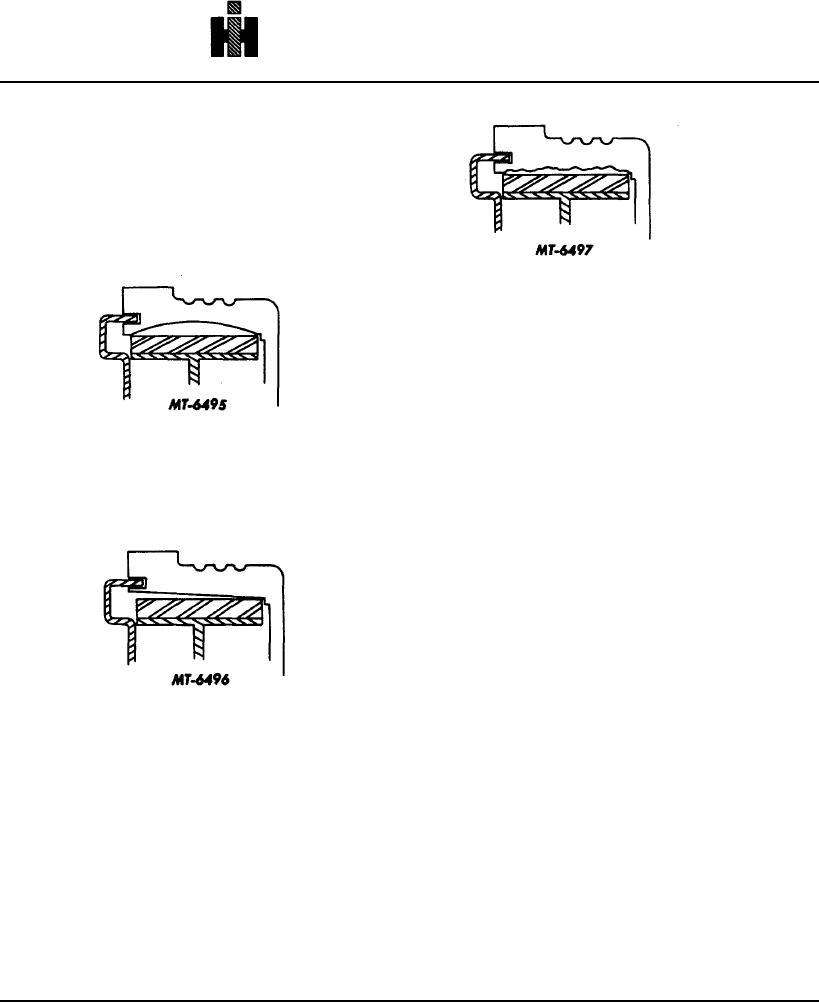
TRUCK SERVICE MANUAL
WHEELS, RIMS, TIRES
CHAPTER II
BRAKE DRUMS
INSPECTION
The friction surface of brake drums must be
smooth, true and concentric whether for air or hydraulic
brakes. Make certain with a visual check that drums are
not barrel shaped, bellmouthed, scored or eccentric. A
barrel shaped drum (Fig. 1) results from overheating. If
this barrel shaped condition is not corrected, the braking
surface is reduced and uneven lining wear results.
Fig. 3
brake drum surface will quickly destroy new lining and
make effective braking impossible.
Brake lining in an eccentric or out of-round drum
cannot make full contact with the drum resulting in rapid
or uneven lining wear and could even cause brakes to
seize or chatter. Maximum allowable out-of-round or
eccentricity should be .10 mm (.004").
Fig. 1
Extreme pressure which over a period of time will create
If inspection shows that any of the preceding
a bellmouthed drum is shown in Fig. 2. Brake linings on a
conditions exist, brake drum should be either turned or
bellmouthed brake drum will make contact only on the
replaced. To assure a balanced braking system, always
inner surface of the drum. In addition to cutting the
install turned or new brake drums in pairs on each axle.
braking surface to a minimum, it will also cause uneven
and rapid wear.
Any time a new brake drum is to be installed on
a vehicle, the runout should be checked as follows. Place
the new brake drum with hub and wheel assembled in
lathe making certain drum is centered.
Mount Dial Indicator SE-1848 on lathe and check runout
about 12.7 mm (.5") in from end of drum as shown in Fig.
4. Runout must not exceed .38 mm (.015").
NOTE: Before assembling drum, hub and wheel, all
Fig. 2
parts must be clean and free of foreign matter.
Scored drums are the result of worn linings to the point
If runout exceeds .38mm (.015") remove drum
where the drum-to-shoe contact is made or an
from hub, rotate drum 180 and reinstall on hub. Check
accumulation of small steel particles imbed themselves
runout again; if runout still exceeds .38mm (.015"),
in the brake lining (Fig. 3). The steel particles form a
remove drum from hub and rotate drum 1/4 turn.
tough scale which is sometimes harder than the drum.
Reinstall drum on hub and recheck runout.
As a result deep grooves are formed in friction surface of
drum.
REFINISHING BRAKE DRUM
Brake drum scoring never improves but continually gests
On brake drums manufactured after January 1,
worse until both lining and brake drum are useless.
1971, the maximum diameter to which drum can be worn
Attempting to reline brakes without turning scored
is stamped or cast into drum. Drum should be discarded
if worn beyond this limit. Minor scores on brake drum can
be removed with fine emery cloth or steel wool, but
always clean
850

